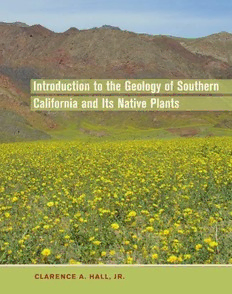
Introduction to the geology of southern California and its native plants PDF
Preview Introduction to the geology of southern California and its native plants
IntroductIon to the GeoloGy of Southern calIfornIa and ItS natIve PlantS the publisher gratefully acknowledges the generous contribution to this book provided by the august and Susan frugé endowment fund in california natural history of the university of california Press foundation. IntroductIon to the GeoloGy of Southern calIfornIa and ItS natIve PlantS clarence a. hall, Jr. Photography by Lauri L. Holbrook University of California Press Berkeley Los Angeles London University of California Press, one of the most distinguished univer sity presses in the United states, enriches lives around the world by advancing scholarship in the humanities, social sciences, and natural sciences. its activities are supported by the UC Press foundation and by philanthropic contributions from individuals and institutions. for more information, visit www.ucpress.edu. University of California Press Berkeley and los angeles, California University of California Press, ltd. london, england © 2007 by the regents of the University of California library of Congress CataloginginPublication Data Hall, Clarence a. introduction to the geology of southern California and its native plants / Clarence a. Hall, Jr.; photography by lauri l. Holbrook. p. cm. includes bibliographical references and index. isBn 9780520249325 (alk. paper) 1. Geology—California, southern. 2. endemic plants—California, southern. i. title. Qe89.H345 2007 557.94'9—dc22 2006037614 Manufactured in China 10 09 08 07 10 9 8 7 6 5 4 3 2 1 the paper used in this publication meets the minimum requirements of ansi/niso Z39.481992 (r 1997) (Permanence of Paper) Cover: Desert sunflower (Geraea canescens) in Death valley, 2005. Photographer: larry Blakely. in Memoriam Mildred e. Mathias (1906–1995), UCla Professor of Botany the scientist does not study nature because it is useful; he studies it because he delights in it, and he delights in it because it is beautiful. if nature were not beautiful, it would not be worth knowing, and if nature were not worth knowing, life would not be worth living.1 jules henri poincaré (1854–1912) 1“le savant n’étudie pas la nature parce que cela est utile; il l’étudie parce qu’il y prend plaisir et il y prend plaisir parce qu’elle est belle. si la nature n’était pas belle, elle ne vaud rait pas la peine d’être connue, la vie ne vaudrait pas la peine d’être vécue.” Jules Henri Poincaré, 1908, science and Méthode, Paris, e. flammarion (publishers). the english trans lation is from H. Poincaré, 1921 [translation by G. B. Halsted of Poincaré’s contributions], the foundations of science [science and Method, p. 359–546]: new york, the science Press, 553 p. Continuing with the translation by Halsted: “. . . but [beauty] has nothing to do with science. i mean that profounder beauty which comes from the harmonious or der of the parts and which a pure intelligence can grasp . . . on the contrary, intellectual beauty is sufficient unto itself, and it is for its sake, more perhaps than for the future good of humanity, that the scientist devotes himself to long and difficult labors.” (p. 366–367). contentS acknowledGmentS xiii astrochronology 40 Geochronology 41 radiometric age Dating 41 Part one How radiometric Dating Works 41 Introduction rocks and Minerals Dated by various radiometric Methods 47 1 this Book 3 Correlating Geologic ages/stages 47 the importance of european stages 48 2 Prologue to Geology of Great valley Group 48 Southern california 5 Mammal ages 51 some early studies of Geology 5 Molluscan stages 54 the Geologic Map 6 Microfossil stages 56 Geologic explorations in California 6 Glacial and interglacial stages 59 some significant Contributions to the Geology evolution 63 of California 6 5 Plate tectonics 64 Midoceanic ridges and trenches 64 Part two san andreas fault and Continental the earth and Geologic time Drift 65 Continental Drift 65 Magnetism and Paleomagnetism 66 3 earth materials 11 Magnetic signatures of rocks 66 the Universe 11 Magnetic reversals 66 early Universe 11 seafloor spreading 66 solar system 11 Hot spots and Mantle Plumes 69 the earth 12 faults 69 rocks 15 transform faults 70 igneous rocks 15 fracture Zones 71 sedimentary rocks 23 triple Junctions 71 Metamorphic rocks 33 Moving Plates 71 4 Geologic time 38 supercontinents 72 Biostratigraphy 40 Plate Boundaries 72 Magnetostratigraphy 40 Continental Margins and orogenies 73
